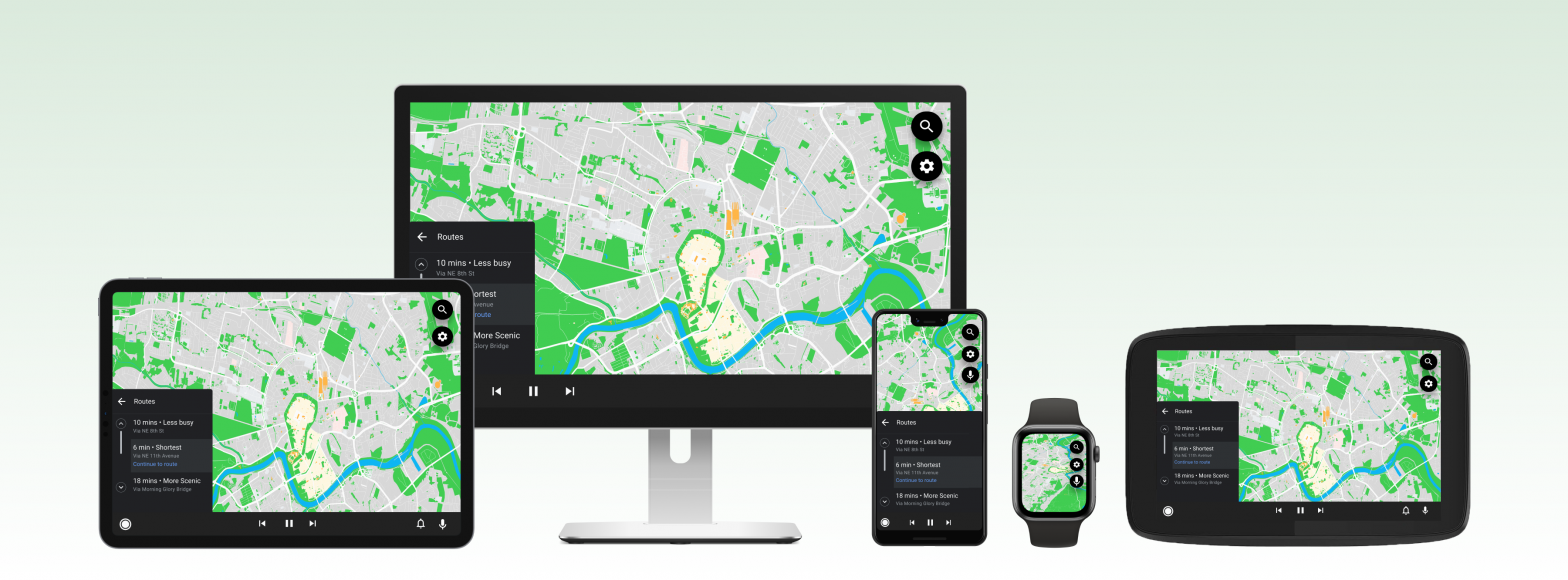Cross-platform app development or Why should I choose Qt?

One code – many platforms, or get two apps for the price of one. Sounds too good to be true? Well, it is true. If you’re still searching for a solution to get your software running on various devices with different operating systems with slight or no change in code, consider Qt, a cross-platform application framework. Software developed with Qt can run on Windows, OS X, Linux, Android, iOS, QNX, BlackBerry, and a number of other platforms. Let’s have a closer look to understand what is Qt.
What is Qt?
Qt framework is a cross-platform framework, written in C++, designed for developing applications for desktop and mobile devices, as well as embedded systems. Qt combines a cross-platform software development application, a graphical user interface (GUI) framework, and a toolkit for developing apps using C++ standards.
This object-oriented cross-platform framework comes with Qt Creator, an IDE that runs on Linux, Android, Windows, macOS, and other systems. It provides developers with all the functionality required to build cross-platform software.
Considering the fact that Qt uses C++, it is entirely object-oriented and supports extensible and true component programming. GUIs can be written directly in C++ using its Widgets module, as it comes with Qt Designer — an interactive graphical tool integrated into Qt Creator.
Qt QML is a specific declarative language — Qt Meta Language, or Qt Modeling Language. It is used to create cross-platform libraries and applications. Qt QML provides both QML and C++ APIs, which enables app developers to integrate QML code with JavaScript and C++.
The importance of choosing the right technology
There’s no ultimate list of all-purpose pros and cons of a technology: what may be a drawback for one project, is a crucial benefit for another. That’s why we have a totality of languages and frameworks to choose from, which is a blessing and a curse.
There’s no ‘good’ or ‘bad’ framework, as each of them was made for a specific purpose. The technology can be ‘suitable’ or ‘not suitable’. Choosing a framework that is not quite suitable for the project requirements can result in additional costs for re-developing, implementation issues, time losses, etc. The technology choice is kind of crucial here, that’s why we’d like to elaborate on it.
Each programming language has its own structure, methods, and tools, and the software also has its structure, or application logic. Ideally, the basic framework structure should overlap the basic project structure or logic as much as possible. Then we can say that the choice is good. If there are a lot of missing components and inconsistencies, the engineers will need to take additional steps to put everything together.
In other words, you can choose almost any technology for any project, but if the technology wasn’t meant to be used for projects like yours, you will need more third-party components to complete it. Choosing the suitable technology saves a lot of time and effort, as it has more necessary features out-of-the-box so the engineers can just start building the software right away.
The reasons to choose Qt as a leading technology should be based on the project goals. The goals are extremely individual so it’s impossible to cover every reason to eventually choose Qt. Instead, we’d like to cover reasons to consider Qt for your project. Let’s go.

Reasons for considering Qt as a main technology
To make an informed decision, you should understand the tasks that the application should perform and then decide if the Qt framework is the best choice or if it’s better to go for an alternative. Let’s start with some general reasons why use Qt.
Cross-platform availability and portability
Using Qt for application development, engineers can build software for various platforms: desktop (Linux, macOS, Windows), mobile (iOS, Android), tvOS, watchOS, Universal Windows Platform, and embedded platforms. There’s no need to rewrite a dedicated code on native technology, which results in faster development and reaching more users with a single app.
Versatility
Qt is used for the development of desktop apps, mobile apps, apps for embedded systems, IoT solutions, and more. With Qt software development services, you can choose the direction that corresponds to the project needs most and scale anytime. For instance, you can start with a desktop app and then add mobile or IoT without changing the team.
Full stack of tools
Qt has a wide range of development tools, including an interface editor and tools for databases, graphical elements, and more. It means the developers will have more tools out-of-the-box to complete more tasks and add more features with no additional effort.
Flexibility and opportunities
Qt allows you to cover many aspects of software, such as
high-quality graphic interfaces
multimedia
network
web
WebAssembly
If your project involves some or all of the aspects listed above, Qt is definitely worth considering.
Multiple language interfaces
If you’re targeting several countries of different languages, don’t underestimate the importance of multilingual interfaces. This requirement is a telltale sign to consider Qt: the framework allows for creating UIs in different languages.
Updates and support
Qt has a huge community so the developers can easily access the documentation and get help solving difficulties. Apart from that, there’s commercial support from The Qt Company which can provide help for hard cases and offer access to exclusive functions by request.
Advantages of using Qt app development framework
Let’s now talk about the advantages of Qt over native programming and other cross-platform options.
Multi-platform availability
Qt app development allows porting an application to multiple target platforms through simple recompilation. It increases development productivity and decreases time to market, making applications future-proof. Qt development saves time, through one source code deployed across all screens and platforms.
Simplified strategy and reduced costs
Thanks to ready-to-go tools, development can be faster and easier. Qt offers a wide range of instruments and classes to work with graphics, multimedia, databases, networks, UI elements, etc. making the framework suitable for pretty much any project. Choosing Qt means less of a headache pondering suitable technologies for the project.
C++ included
Since Qt is based on C++, it includes some C++ benefits that make it possible to reuse the code. Using C++ software developers have greater control and can create apps of any scale: from small mobile apps to complex high-performance systems.
Performance
The code is compiled to native binaries that run at full speed. It means that there’s no need to use a virtual machine to run the application, like with Java development. The app runs natively, allowing for better performance.
Single codebase
Qt cross-platform software development makes it easy to create intuitive experiences for all users, no matter what system is used. It’s a significant time and resource saver.
Stable and reliable framework
Qt is used in many industrial applications and solutions, confirming it to be reliable and stable. Furthermore, The Qt Company offers commercial support for highly specialized or hard development tasks. This means the engineers won’t be left to chance once they encounter unusual problems.
UI-oriented
Qt offers tools to create various user interfaces, including responsive design, animation, stylization, etc. It may be not 100 percent native-looking, but you’ll be surprised with how flexible a cross-platform framework can be.
Disadvantages of using Qt app development framework
Let’s now talk about difficulties that clients and engineers can encounter while working with Qt.
A more complicated UX
The user experience of the developed apps is not so smooth. On desktop platforms, it is easier to develop a native user experience because there are more common patterns and widgets. Mobile UX is different and there’s a lack of platform-specific things. With the default components in Qt mobile development, you do not get an ideal look and feel of iOS and Android.
Licensing pitfalls
Qt offers LGPL, but it has limitations and requirements that you should satisfy if you are planning to distribute your applications. In some cases, the only acceptable choice is purchasing a commercial license.
Source file size
Qt-based applications can have big source file sizes because of the Qt libraries. The source file size can affect the entire application size and load speed.
Additional resources
To complete some tasks it may be necessary to address additional resources, language bindings, or commercial support that can elevate the price of the project.
Version choice
Qt is updated regularly. Since you have to consider platform and library compatibility, it can be a tricky task to choose the most optimal Qt version to start developing your application.
Excessive complexity for small projects
Some Qt functions may seem superfluous for projects where simplicity and ease of use are a priority. Arguably a disadvantage, yet it’s good to know to make an informed decision.
Concervativeness
Qt is relatively slow in adopting the novelties in the software development area. If you’re a fan of new trends and technologies, it can be quite a challenge to implement these into your project.
Qt instruments for embedded platforms
Talking about Qt in embedded systems, software developers make use of the following tools:
Qt for Embedded Linux: a toolbox for developing software on Linux-based embedded systems. It’s good for creating GUIs, managing networks and other aspects of the embedded system
Qt for Automation: a toolbox for creating industrial automation and monitoring applications. It is used to work with sensors, industrial devices and communications.
Qt for Device Creation: tools for developing embedded devices with optimized applications. They enable working with various devices, including smartphones and tablets.
Qt for MCUs: tools for microcontrollers help build apps for resource-constrained embedded systems, allowing the optimization of code size and memory usage.
Qt Automotive Suite: tools for developing apps for infotainment, navigation, auxiliary systems, and other automotive systems. The toolbox allows for the creation of modern interfaces for automotive apps.
Qt Industrial Automation: tools for developing apps to control manufacturing and production systems, measure indicators, and complete other production-related tasks.
Qt Wearable: a dedicated toolbox for the creation of apps for wearable apps, including smartwatches, fitness trackers, and other wearables.
There are also Qt components for developing embedded systems:
Qt Lite: a built-in Qt subproject. A light version that allows using only the necessary components. This helps reduce the app’s size and make it resource-efficient.
Qt Safe Renderer: a tool for developing safe interfaces for automotive systems and other applications where high reliability and lack of errors are a must.
Qt SCXML: the tool supports State Chart XML and allows the creation and management of state machines for embedded systems.
Qt MQTT: Enables message exchange protocol MQTT which is often used in smart systems and IoT.
Qt SerialBus: allows working with serial ports RS-232 and RS-485 to ensure connection with various external devices.
Qt Bluetooth: enables interaction with devices via Bluetooth, which can be useful for wearable devices and other purposes.
Qt NFC: enables support of Near Field Communication, or NFC technology to exchange data between devices.
Qt WebView: used for Qt web development. Allows developing Qt web applications and building Qt web pages and web content into apps. This feature may be of use for creating hybrid applications.
Qt and C++ for embedded devices
Why choose C++ and Qt for embedded devices?
C++ sits between hardware and high-level software, allowing developers to access hardware while still making use of higher-level language benefits. Almost every embedded system is required to work for a long time, being stable and reliable, and that’s where C++ is pretty much the best. C++ is built on algorithms and this structure corresponds well to the structure of embedded projects, making a perfect match.
C++ is quite a complicated language, and here’s where Qt comes into play. Since Qt is based on C++, it allows developers to use C++ libraries and benefit from the language’s flexibility. Qt engineers can create embedded systems with user-friendly interfaces, Bluetooth connectivity, internet access, and more. It can be software for a wide range of screen resolutions, infotainment car systems, medical embedded systems, etc.
Qt is an excellent choice for both GUI and non-GUI applications. If you need to create a GUI application that can run on multiple platforms, this framework is the optimal choice. Additionally, it enables you to develop high-performance applications more quickly.
Other multi-platform solutions as alternatives to Qt
Talking about cross-platform development, we can’t but mention other popular programming languages that can replace Qt if it doesn’t match your project well.
Flutter
Framework for developing mobile and web applications using Dart programming language. It allows the creation of apps for Android, iOS, web, and other platforms.
React Native
Framework for developing apps on JavaScript and React. It allows the creation of cross-platform iOS and Android applications with a joint codebase.
Electron
Framework for developing desktop applications using web technologies like HTML, CSS, and JavaScript. Electron-based apps can work on Windows, macOS, and Linux using a single codebase.
JavaFX
Set of tools and libraries for developing graphical interfaces with Java. JavaFX allows for the creation of cross-platform apps working on various OS.
Python Kivy
A library and framework for developing multimedia apps using Python. Python Kivy is compatible with various platforms, including Windows, macOS, Linux, Android, and iOS.
The choice of framework depends on the project’s requirements and needs. Each framework has its benefits and limits that aren’t obvious at the beginning of the project. Figuring everything out may be a tricky task, especially if you’re new to cross-platform development. To make sure you make the right choices, consult the specialists before making the final decision.
Where Qt is used
We can encounter Qt in a wide range of industries and applications due to its versatility, cross-platform capabilities, and extensive feature set. Some of the areas where Qt is commonly used include
Desktop applications
Embedded systems
Mobile app development
Automotive industry
Industrial automation
Aerospace and defense
Gaming
Smart TVs and set-top boxes
IoT
Healthcare and medical devices
Scientific and research applications
Financial and trading platforms
Education
Cases where Qt may be a good option
Keeping in mind that the choice of technology should be based on the project needs and context, we’ll mention several scenarios where Qt is worth considering. The list is based on our experience.
Cross-platform project
Qt allows the development of an app that should work on various platforms. Qt allows developers to build apps for various OS from a single code, reducing time and effort for porting the software to each platform.
Embedded and IoT system with an interface
Say, you need an embedded system with a nice interface. Qt has all the necessary tools to work with hardware and create interfaces for embedded systems like industrial controllers, medical devices, automotive digital systems, and more.
Multimedia and graphics on multiple platforms
Qt has a lot of features to work with multimedia projects, making the framework a perfect choice for developing graphical editors, video and audio editing tools, and 2D and 3D graphics apps. Qt offers a rich choice of instruments for projects that require a user-friendly and intuitive graphic interface. Cross-platform availability included.
Mobile development 2 in 1
If you are looking for an optimal way to target all mobile devices, Qt is worth considering. Qt allows developers to build cross-platform mobile apps for Android and iOS, reducing time and effort in comparison to native development.
Limited development time
If you’re short of time, Qt allows you to speed up the development process due to cross-platform availability and rich choice of ready-to-go tools. You have an all-in-one app for all platforms within a shorter time.
The existing software is already built with Qt
Say, you already have Qt-based software and want to update or rework it. If you’re happy with the performance of an old app and the team, you may want to continue with Qt for not to lose previous results.
Limited budget
Say, you need an app for several platforms, but you can’t allocate resources for hiring dedicated teams of developers for each target platform. Qt can give you a chance to launch the project and make it successful while staying within the budget.
Qt success stories
Because Qt technology provides modules for cross-platform application development in various areas, the Qt company itself has an impressive portfolio.
Vakoms as a Qt development company has more to add to the list. Some of the Qt projects in our portfolio include:
A mobile app for controlling a spectroscope
A perfusion imaging software that analyses CT and MRI scans using ML
A home automation software consisting of a custom tablet as a control panel and a set of sensors
A desktop application for the Swiss manufacturer of polymer production equipment, for internal use
A desktop project management app that can be used with no internet connection
An IoT home automation system for controlling indoor temperature and ventilation
Software for a smart photo booth for configuring the hardware and collecting and analyzing data
Check out our dedicated Qt page for more information.
Conclusion
The technology choice shouldn’t be overlooked when starting a software development project. Consider Qt for apps that should work on multiple platforms, for IoT and embedded systems, for projects with limited time or budget, and for projects with a possibility of scaling in the future. Before making the final decision, consult an expert to make sure that your choice is based exactly on your project’s goals and requirements.




